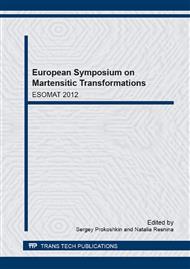p.326
p.332
p.338
p.344
p.348
p.352
p.357
p.362
p.367
Shape Memory Effect in NiTiCo Strip Produced by Twin Roll Casting Technique
Abstract:
The ternary Ni47Ti50Co3 alloy was produced using twin roll technique and traditional casting. The bulk alloy was hot rolled and thermally treated. Both alloys showed presence of the reversible martensitic transformation, in which the parent phase transformed to the B19’monoclinic martensite via the R-phase. However, they significantly differed in grains orientation. Thermally treated alloy showed weak fibre texture (35% of total amount), whereas the strip revealed fibre and {100} sheet texture components. In the strip more than 70% of total amount of grains were preferentially oriented. Presence of the texture affected the shape memory effect. In the strip, the two-way shape memory effect was induced after 30 training cycles. In thermally treated bulk, 52% of shape recovery was reached after 100 training cycles.
Info:
Periodical:
Pages:
348-351
Citation:
Online since:
January 2013
Authors:
Price:
Сopyright:
© 2013 Trans Tech Publications Ltd. All Rights Reserved
Share:
Citation:


